A Multi-Resolution Mode CMOS Image Sensor with a Novel Two-Step Single-Slope ADC for Intelligent Surveillance Systems
Abstract
:1. Introduction
2. Intelligent Surveillance Systems
3. Circuit Description
3.1. Structure of the CMOS Image Sensor (CIS)
3.2. Multi-Mode Pixel Resolution
3.3. Proposed Two-Step Single-Slope ADC (TS SS-ADC)
4. Experimental Results
4.1. Simulation Results and Chip Photograph
4.2. Measurement Results
5. Conclusions
Acknowledgments
Author Contributions
Conflicts of Interest
References
- Ibrahim, S.W. A comprehensive review on intelligent surveillance systems. Commun. Sci. Technol. 2016, 1, 7–14. [Google Scholar]
- Fernandez, J.; Calavia, L.; Baladr, C. An intelligent surveillance platform for large metropolitan areas with dense sensor deployment. Sensors 2013, 13, 7414–7442. [Google Scholar] [CrossRef] [PubMed]
- Choi, J.; Park, S.; Cho, J.; Yoon, E. A 1.36 μW adaptive CMOS image sensor with reconfigurable modes of operation from available energy/illumination for distributed wireless sensor network. In Proceedings of the IEEE International Solid-State Circuits Conference Digest of Technical Papers (ISSCC), San Francisco, CA, USA, 19–23 February 2012; pp. 112–114. [Google Scholar]
- Couniot, N.; Streel, G.; de Botman, F.; Lusala, K.A.; Flandre, D.; Bol, D. A 65 nm 0.5 V DPS CMOS Image Sensor with 17 pJ/Frame.Pixel and 42 dB Dynamic Range for Ultra-Low-Power SoCs. IEEE J. Solid-State Circuits 2015, 50, 2419–2430. [Google Scholar] [CrossRef]
- Choi, J.; Park, S.; Cho, J.; Yoon, E. A 3.4-μW Object-Adaptive CMOS Image Sensor with Embedded Feature Extraction Algorithm for Motion-Triggered Object-of-Interest Imaging. IEEE J. Solid-State Circuits 2014, 49, 289–300. [Google Scholar] [CrossRef]
- Snoeij, M.F.; Theuwissen, A.J.P.; Makinwa, K.A.A.; Huijsing, J.H. A CMOS Imager with Column-Level ADC Using Dynamic Column Fixed-Pattern Noise Reduction. IEEE J. Solid-State Circuits 2006, 41, 3007–3015. [Google Scholar] [CrossRef]
- Snoeij, M.F.; Theuwissen, A.J.P.; Makinwa, K.A.A.; Huijsing, J.H. Multiple-ramp column-parallel ADC architectures for CMOS image sensors. IEEE J. Solid-State Circuits 2007, 42, 2968–2977. [Google Scholar] [CrossRef]
- Lee, D.; Han, G. High-speed, low-power correlated double sampling counter for column-parallel CMOS imagers. Electron. Lett. 2007, 43, 1362–1364. [Google Scholar] [CrossRef]
- Artyomov, E.; Rivenson, Y.; Levi, G.; Yadid-Pecht, O. Morton (Z) Scan Based Real-Time Variable Resolution CMOS Image Sensor. IEEE Trans. Circuits Syst. Video Technol. 2005, 15, 947–952. [Google Scholar] [CrossRef]
- Huang, H.Y.; Conge, P.A.; Huang, L.W. CMOS Image Sensor Binning Circuit for Low-Light Imaging. In Proceedings of the 2011 IEEE Symposium on Industrial Electronics and Applications (ISIEA), Langkawi, Malaysia, 25–28 September 2011; pp. 586–589. [Google Scholar]
- Lim, S.; Lee, J.; Kim, D.; Han, G. A high-speed CMOS image sensor with column-parallel two-step single-slope ADCs. IEEE Trans. Electron. Devices 2009, 56, 393–398. [Google Scholar] [CrossRef]
- Choi, J.; Han, S.; Kim, S.; Chang, S.; Yoon, E. A Spatial-Temporal Multiresolution CMOS Image Sensor with Adaptive Frame Rates for Tracking the Moving Objects in Region-of-Interest and Suppressing Motion Blur. IEEE J. Solid-State Circuits 2007, 42, 2978–2988. [Google Scholar] [CrossRef]
- Hanson, S.; Sylvester, D. A 0.45–0.7 V Sub-Microwatt CMOS Image Sensor for Ultra-Low Power Applications. In Proceedings of the 2009 Symposium on VLSI Circuits, Kyoto, Japan, 16–18 June 2009; pp. 176–177. [Google Scholar]
- Yamada, T.; Kasuga, S.; Murata, T.; Kato, Y. A 140 dB-Dynamic-Range MOS Image Sensor with In-Pixel Multiple-Exposure Synthesis. In Proceedings of the IEEE International Solid-State Circuits Conference Digest of Technical Papers (ISSCC), San Francisco, CA, USA, 3–7 February 2008; pp. 50–51. [Google Scholar]
- Ham, S.H.; Lee, Y.H.; Jung, W.K.; Lim, S.H.; Yoo, K.S.; Chae, Y.C.; Cho, J.H.; Lee, D.M.; Han, G.H. A CMOS Image Sensor with Analog Gamma Correction Using a Nonlinear Single Slope ADC. In Proceedings of the 2006 IEEE International Symposium on Circuits and Systems (ISCAS), Island of Kos, Greece, 21–24 May 2006; pp. 3578–3581. [Google Scholar]
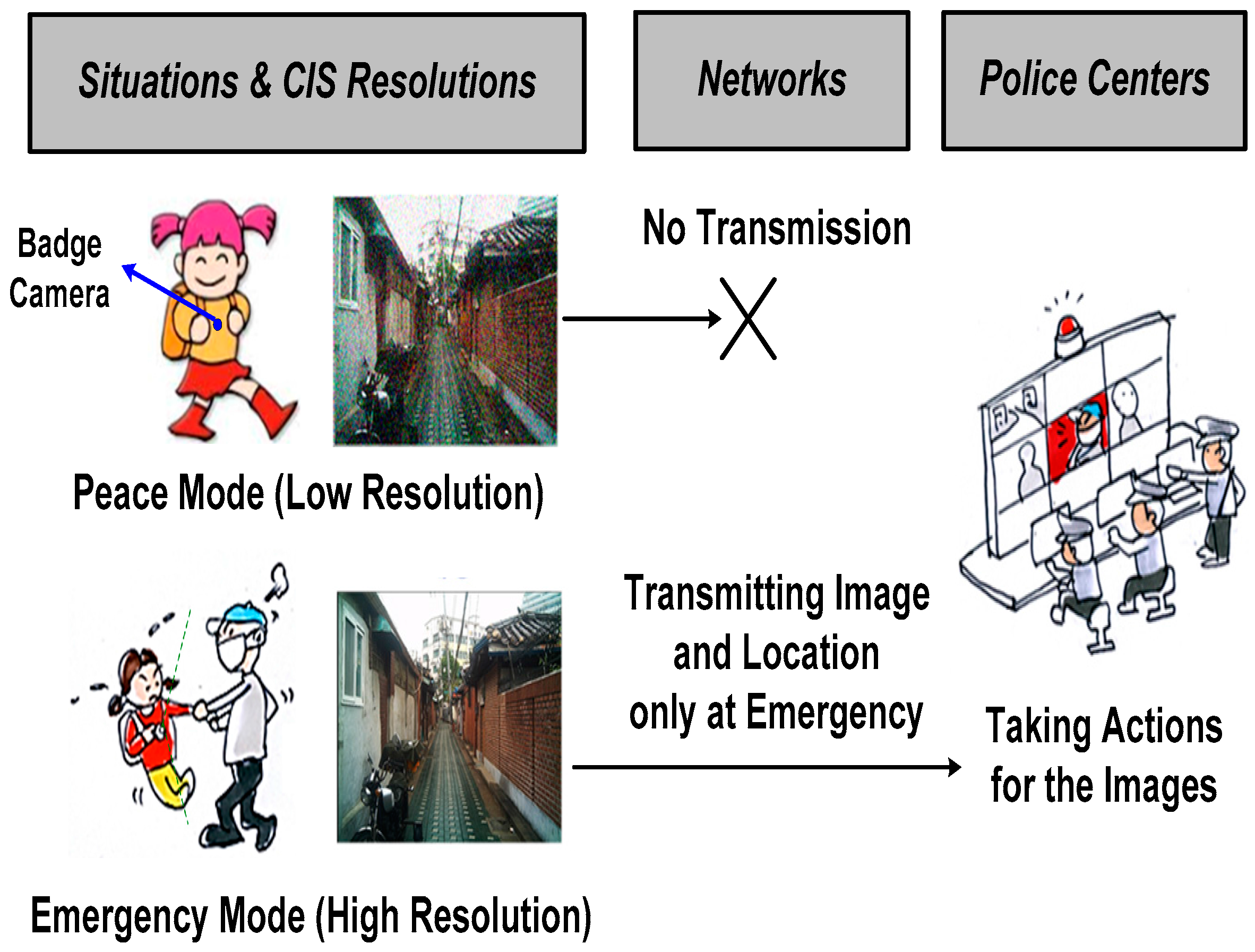
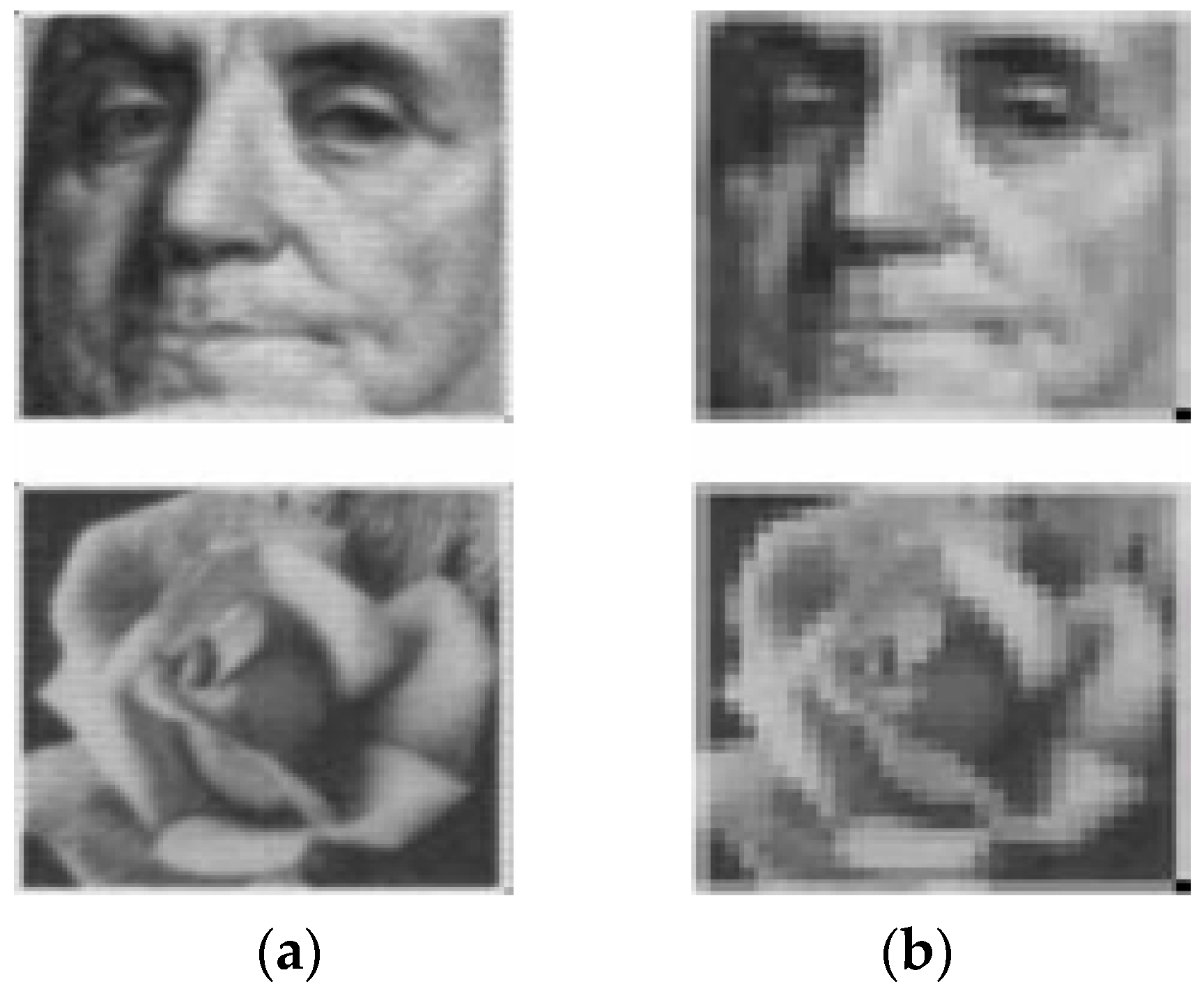
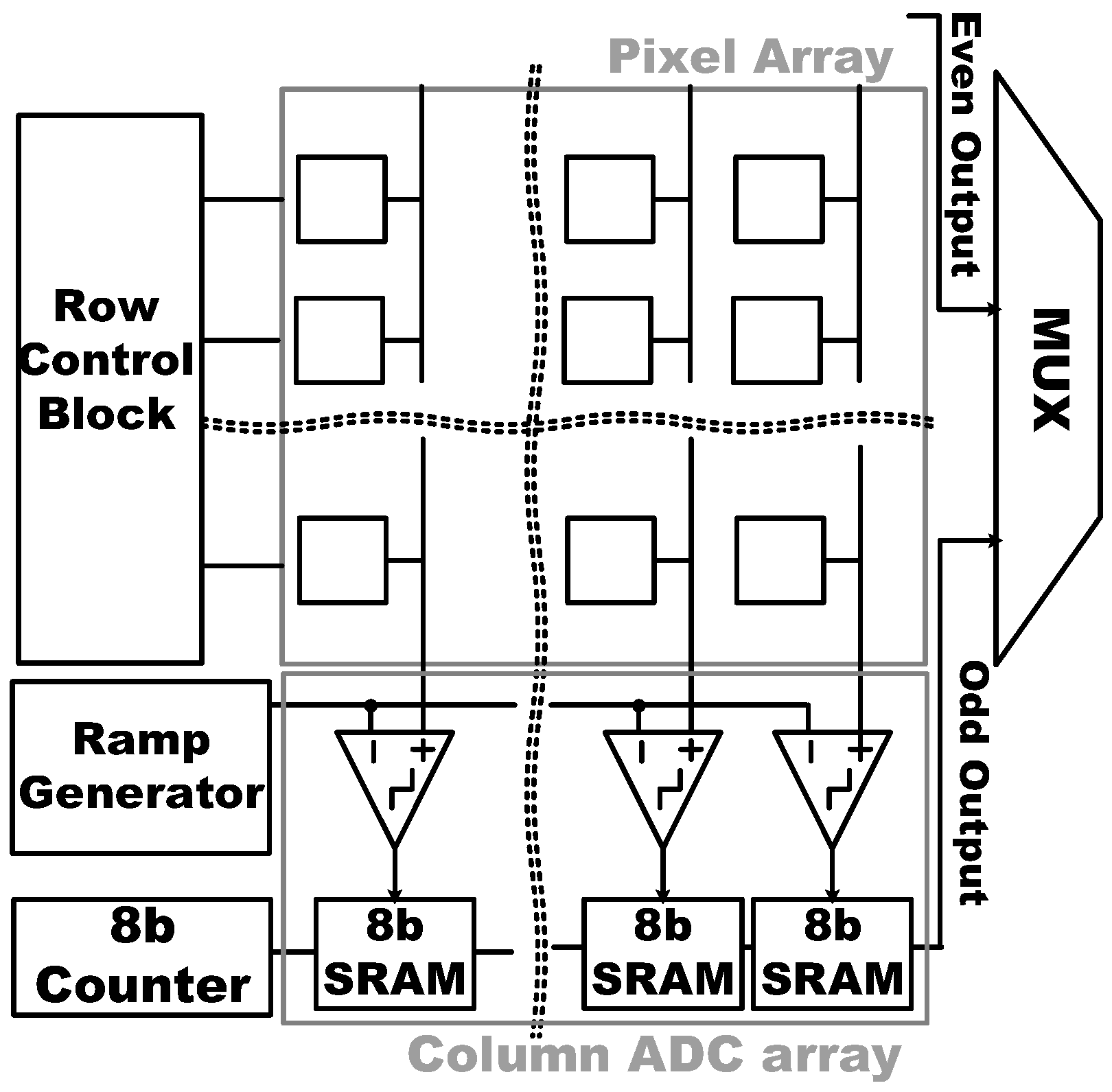
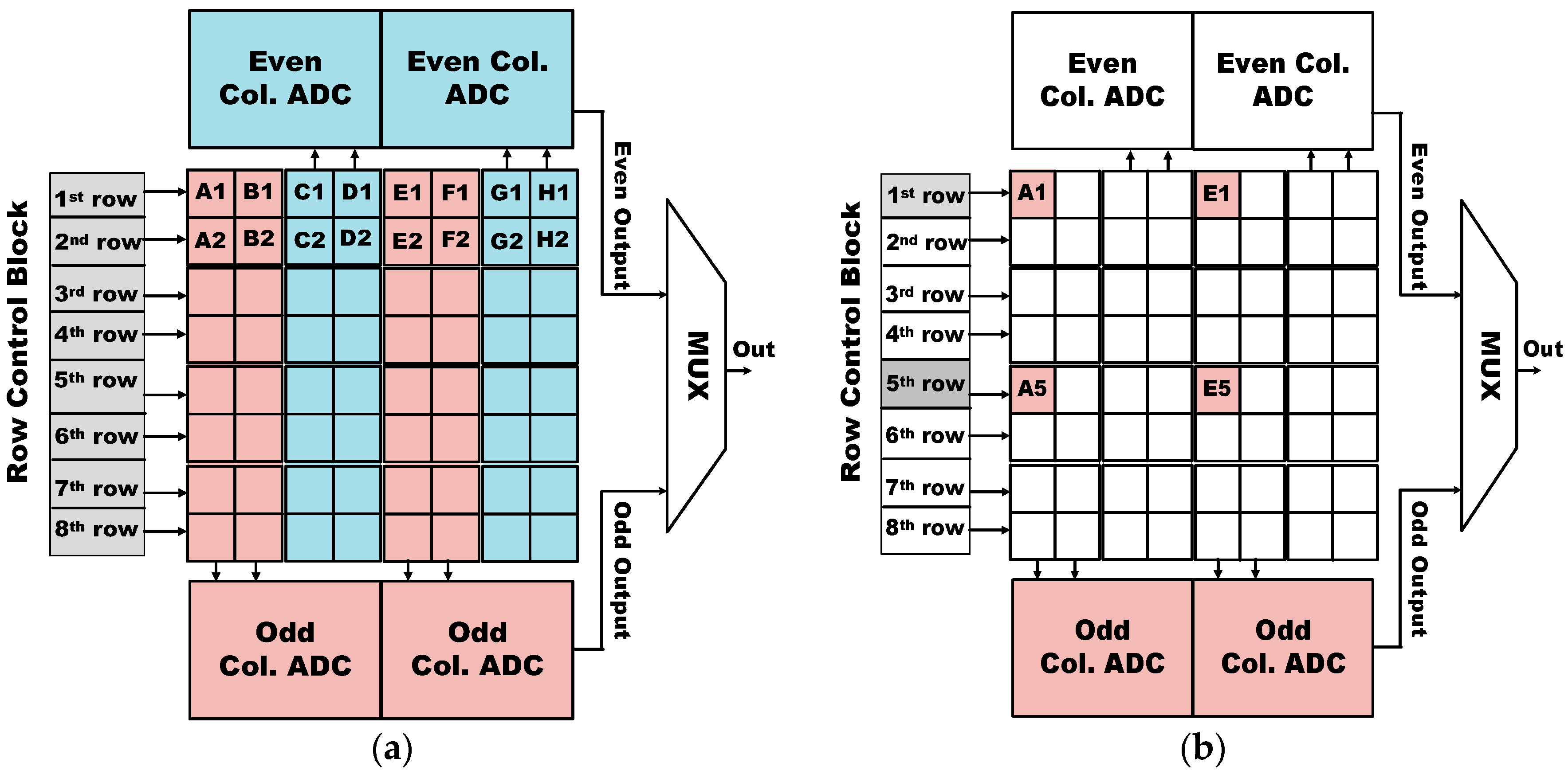

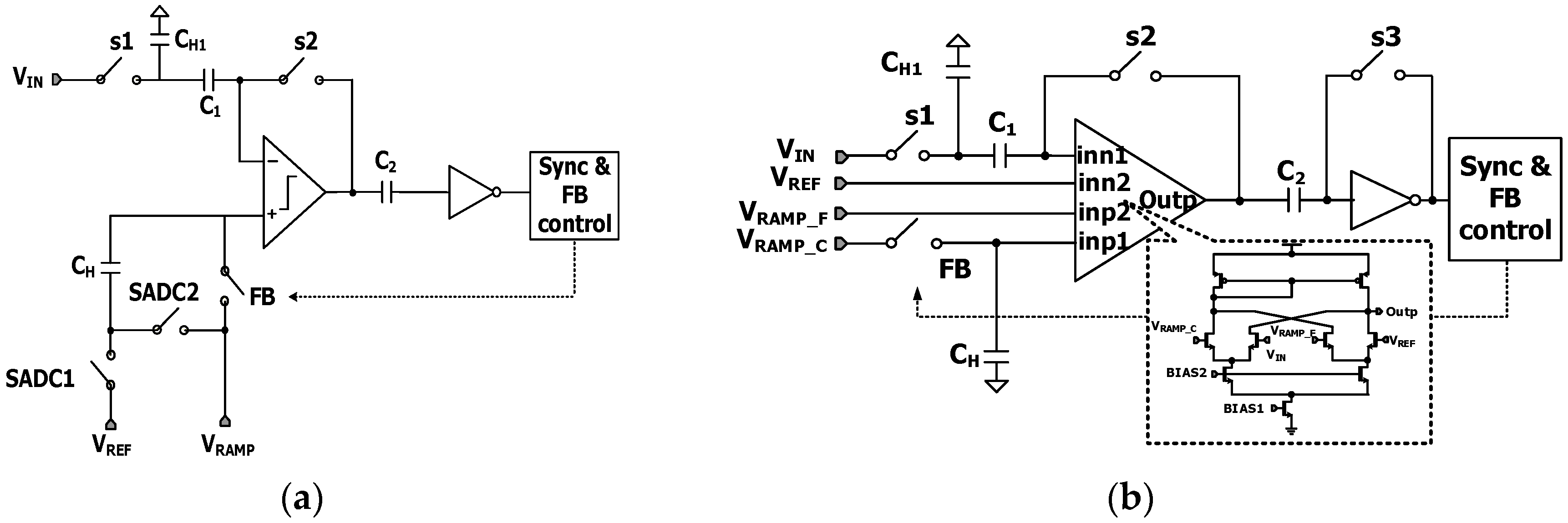
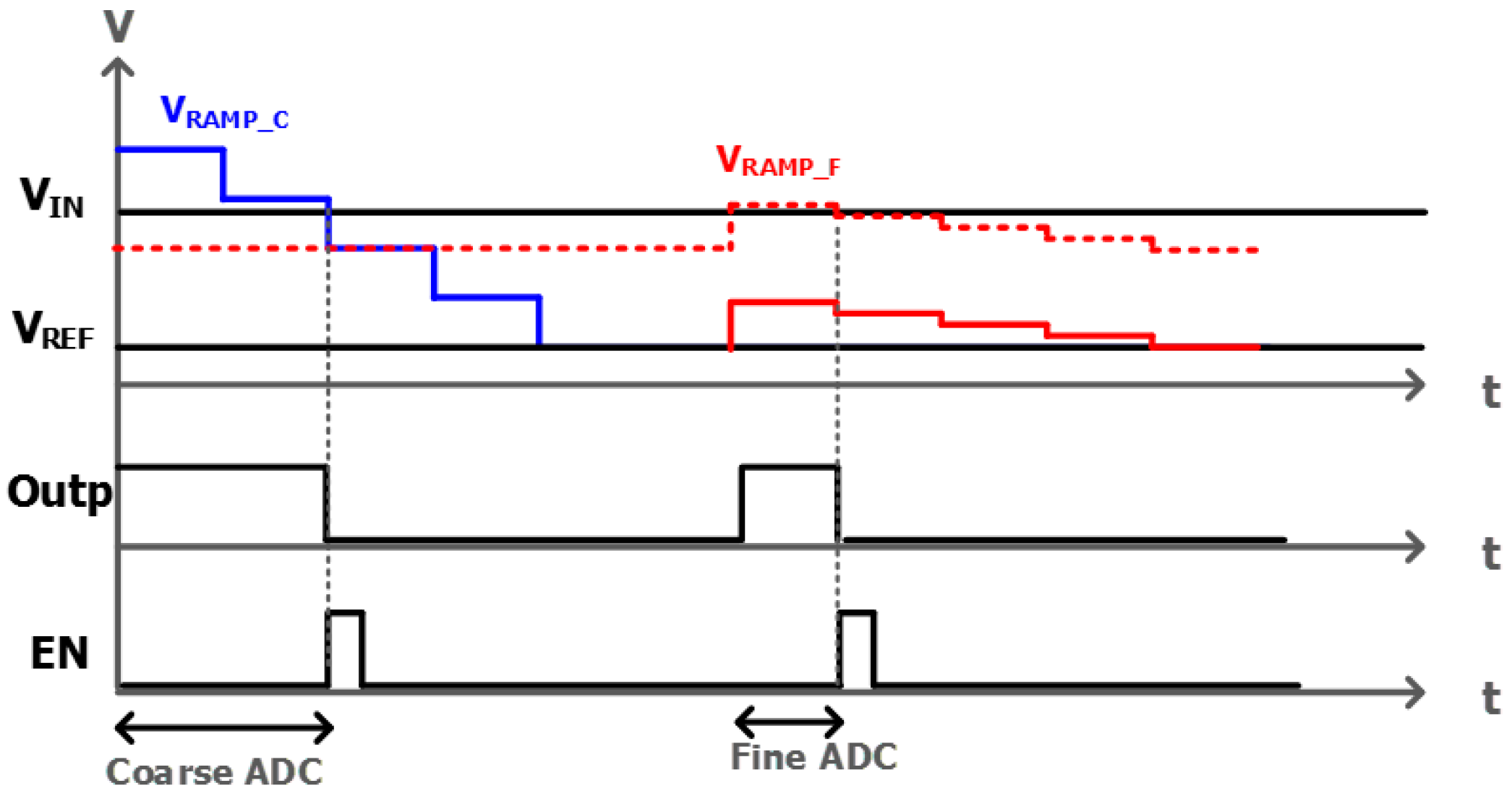

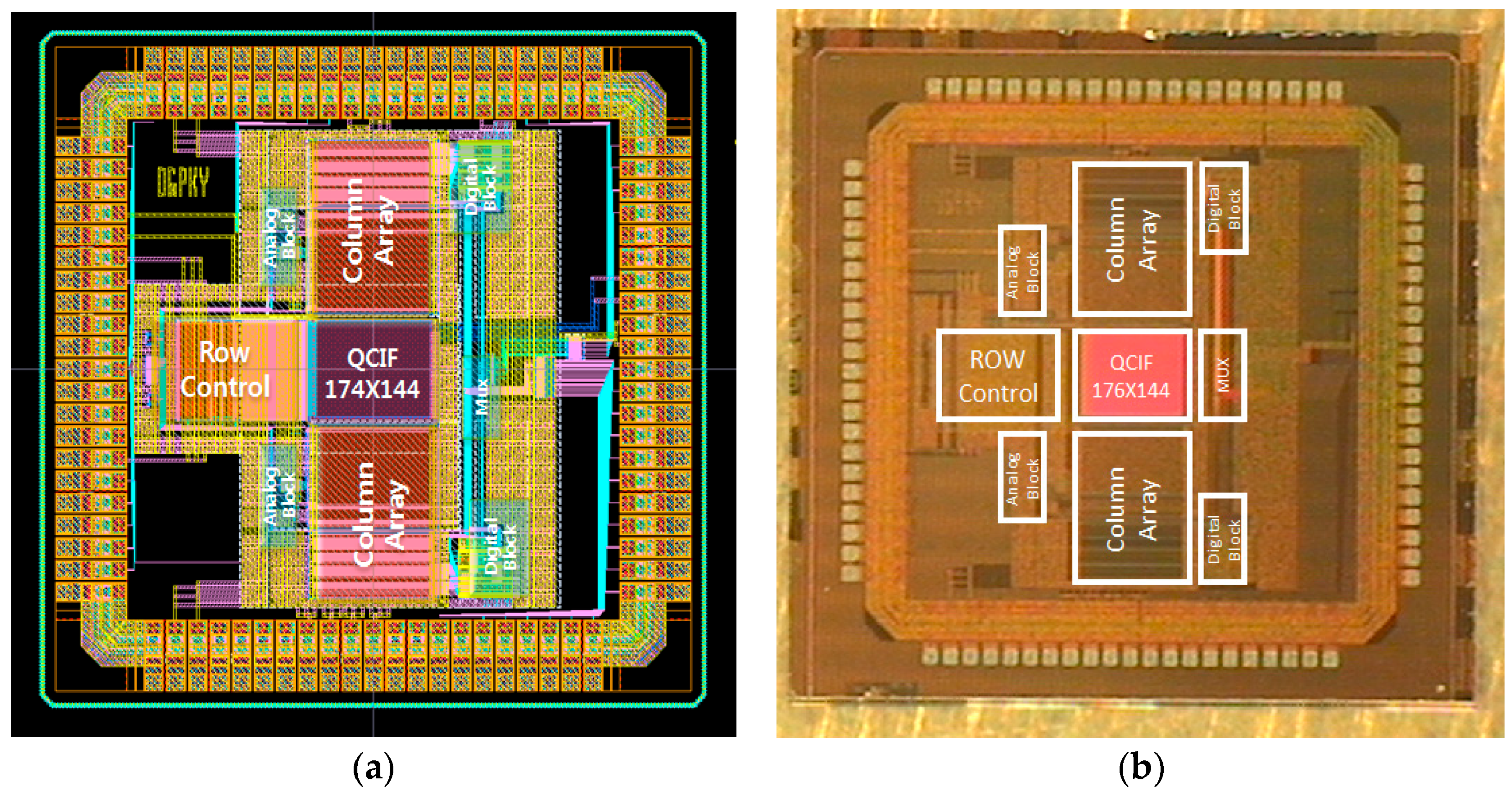
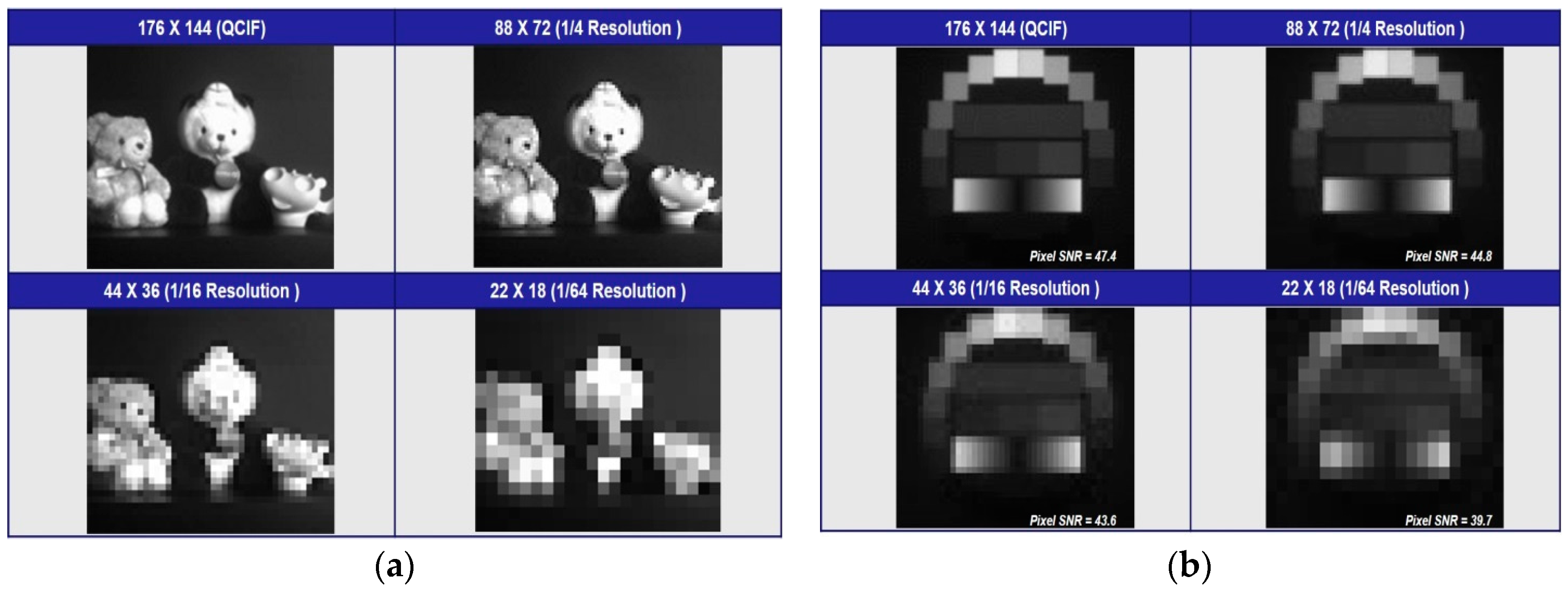
| Array Format | QCIF (176 × 144) |
| Pixel Size | 4.4 μm × 4.4 μm |
| Fill Factor | 9% |
| Dynamic Range | 61.8 dB |
| ADC Resolution | 8-bit |
| Frame Rate | 14 frame/s |
| Power Supply | 3.3 V (analog)/1.8 V (digital) |
| Power Consumption | 10 mW (High-resolution mode) |
| 0.3 mW (1/64 resolution mode) | |
| 11.3 μW(per column) | |
| 0.4 μW (per column @power shut off) | |
| SNR | 47 dB (High-resolution mode) |
| 39.7 dB (1/64 resolution mode) | |
| Area | 5.52 mm2 (2.35 mm× 2.35 mm) |
| Process | Towerjazz 0.18 μm CIS |
| Ref. | Pixels | Technology | Frame Rate | Power | Power FOM | Read-Out |
|---|---|---|---|---|---|---|
| (μm) | (fps) | (mW) | (nW/pixels∙fps) | Method | ||
| [9] | 128 × 128 | 0.35 | 30 | 30 | 61.04 | Single ADC (SAR 1) |
| [12] | 256 × 256 | 0.35 | 30 | 75 | 38.01 | Column ADC (SS 2) |
| [13] | 128 × 128 | 0.13 | 9 | 16 | 108.51 | In-pixel ADC |
| [14] | 176 × 144 | 0.25 | 30 | 20 | 26.31 | External ADC |
| [15] | 320 × 240 | 0.35 | 15 | 30 | 26.04 | Column ADC (SS) |
| This work | 176 × 144 | 0.18 | 14 | 10 | 28.18 | Column ADC (TSSS 3) |
| 1/64 mode | 896 | 0.3 | 0.85 |
© 2017 by the authors. Licensee MDPI, Basel, Switzerland. This article is an open access article distributed under the terms and conditions of the Creative Commons Attribution (CC BY) license (http://creativecommons.org/licenses/by/4.0/).
Share and Cite
Kim, D.; Song, M.; Choe, B.; Kim, S.Y. A Multi-Resolution Mode CMOS Image Sensor with a Novel Two-Step Single-Slope ADC for Intelligent Surveillance Systems. Sensors 2017, 17, 1497. https://doi.org/10.3390/s17071497
Kim D, Song M, Choe B, Kim SY. A Multi-Resolution Mode CMOS Image Sensor with a Novel Two-Step Single-Slope ADC for Intelligent Surveillance Systems. Sensors. 2017; 17(7):1497. https://doi.org/10.3390/s17071497
Chicago/Turabian StyleKim, Daehyeok, Minkyu Song, Byeongseong Choe, and Soo Youn Kim. 2017. "A Multi-Resolution Mode CMOS Image Sensor with a Novel Two-Step Single-Slope ADC for Intelligent Surveillance Systems" Sensors 17, no. 7: 1497. https://doi.org/10.3390/s17071497






